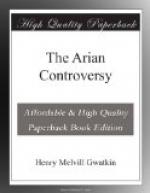[Sidenote: Eastern Council at Seleucia.]
Meanwhile the Easterns met at Seleucia near the Cilician coast. It was a fairly central spot, and easy of access from Egypt and Syria by sea, but otherwise most unsuitable. It was a mere fortress, lying in a rugged country, where the spurs of Mount Taurus reach the sea. Around it were the ever-restless marauders of Isauria. They had attacked the place that very spring, and it was still the headquarters of the army sent against them. The choice of such a place is as significant as if a Pan-Anglican synod were called to meet at the central and convenient port of Souakin. Naturally the council was a small one. Of the 150 bishops present, about 110 were Semiarians. The Acacians and Anomoeans were only forty, but they had a clear plan and the court in their favour. As the Semiarian leaders had put themselves in a false position by signing the dated creed, the conservative defence was taken up by men of the second rank, like Silvanus of Tarsus and the old soldier Eleusius of Cyzicus. With them, however, came Hilary of Poitiers, who, though still an exile, had been summoned with the rest. The Semiarians welcomed him, and received him to full communion.
[Sidenote: Its proceedings.]
Next morning the first sitting was held. The Homoeans began by proposing to abolish the Nicene creed in favour of one to be drawn up in scriptural language. Some of them argued in defiance of their own Sirmian creed, that ’generation is unworthy of God. The Lord is creature, not Son, and his generation is nothing but creation.’ The Semiarians, however, had no objection to the Nicene creed beyond the obscurity of the word of one essence. The still more important of the essence of the Father seems to have passed without remark. Towards evening Silvanus of Tarsus proposed to confirm the Lucianic creed, which was done next morning by the Semiarians only. On the third day the Count Leonas, who represented the Emperor, read a document given him by Acacius, which turned out to be the dated creed revised afresh and with a new preface. In this the Homoeans say that they are far from despising the Lucianic creed, though it was composed with reference to other controversies. The words of one essence and of like essence are next rejected because they are not found in Scripture, and the new Anomoean unlike is anathematized—’but we clearly confess the likeness of the Son to the Father, according to the apostle’s words, Who is the image of the invisible God.’ There was a hot dispute on the fourth day, when Acacius explained the likeness as one of will only, not extending to essence, and refused to be bound by his own defence of the Lucianic creed against Marcellus. Semiarian horror was not diminished when an extract was read from an obscene sermon preached by Eudoxius at Antioch. At last Eleusius broke in upon Acacius—’Any hole-and-corner doings of yours at Sirmium are no concern of ours. Your creed is not the Lucianic, and that is quite enough to condemn it.’ This was decisive. Next morning the Semiarians had the church to themselves, for the Homoeans, and even Leonas, refused to come. ’They might go and chatter in the church if they pleased.’ So they deposed Acacius, Eudoxius, George of Alexandria, and six others.




